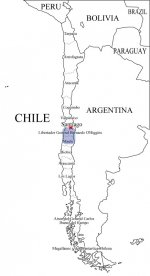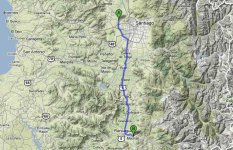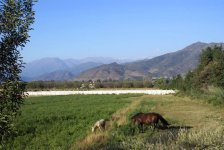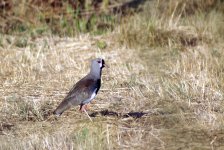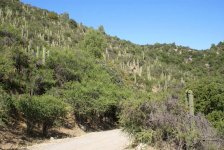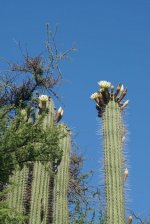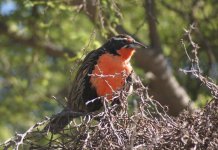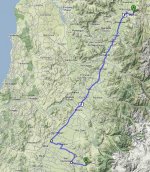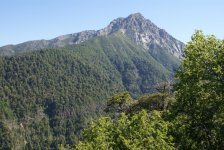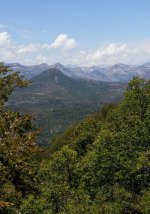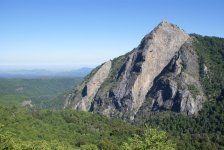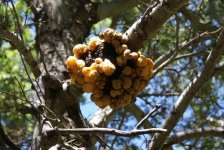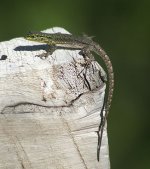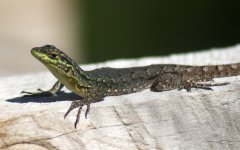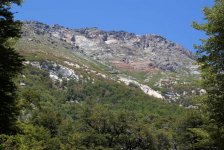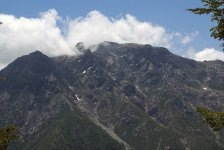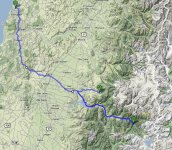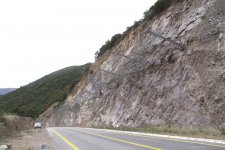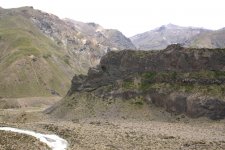Day 1: Dec. 26 Toronto-Sanitiago-Machalí
Arrived in Santiago at about 1245 local time, about half-an-hour late due to headwinds.
As ever, when we arrive at a brand-new destination, DMM and I play the “what will be the first bird?” game. She was betting on Barn Swallow – statistically, one of the safer bets one could make, given that species’ ubiquity (and predilection for airport buildings); I however, was thinking some Killdeer-like beast, given that almost every airport I’ve ever been to, from Cairns to Costa Rica, has some sort of plover (or plover equivalent) on the infield.
In the end, we were both entirely wrong; not a single swallow, of any description - nor any kind of plover – was in sight. Instead, our first bird, seen foraging on a very dry patch of grass just outside the deplaning ramp, was some sort of thrush. It was American Robin-sized, but entirely different in plumage – a sort of warm ochre-brown on the breast, with a darker back. Not wanting to delay too much (we hadn’t even reached immigration yet) we just took some notes and moved along, figuring to look it up later. (Bird #2, incidentally, was seen right along side it – House Sparrow. No shortage of those here. Must be the absence of Sparrowhawks in this country.)
After paying our extortionary “welcome to Chile” fee (see above), picked up our bags and our car, (thankfully without incident) and headed down south on the “Ruta cinco”. What a feeling - a new country, binoculars, and the open road stretching out ahead … !
(Oh – I do apologise, but, even though we’re only two birds in, I’m afraid it’s already time for one of these…)
[Aside] Chilean roads. Another factor in our choice of destination was Chile’s reputation – and this was largely bourne out by experience – for having very well-maintained highways. I can’t personally speak for the roads in more remote parts of the country, but right around Santiago, there is an excellent system of big, fast, multi-lane highways. These are very attractive to us time-pressed foreigners who mostly want a way to get the heck out of Santiago as quickly as possible!
The downside, such as it is, is that all this tarmac needs to be paid for, so there are tolls everywhere (some cash, but mostly electronic toll roads, or ETRs). I don’t mind at all paying these kinds of fees – but the problem is, that if you rent a car in Santiago, you end up paying a flat daily fee for the transponder that the rental companies must provide, in order for you to be able to use these roads at all (it seems that they all do this – recording your actual usuage, and passing that on to you, seems to be too complicated). For those of us who only use these roads twice – on the way to and back from the hinterland – this seems like a terrible rip. However, aside from renting your car in a different city, I could find no way around this…
Outside of the metropolitan area, you will also find tolls on the major, limited-access roads – but these are cash only (so be sure to have some small denominations handy), and very reasonable – I think they ranged from 1500-1900 pesos (about $3 - $4). And even the secondary roads in the regions we visited were in pretty good shape, almost everywhere we went – including some of the ones going way up into the Andes (see, especially, the road up the Rio Maule, which I’ll get to (eventually) on day 4)
The short of it is, we found driving in Central Chile to be a breeze – a lot like home, except with fewer cars! A regular, compact car would have been fine, for most of the roads we used. It was only in the most rural of places that we found ourselves really needing the better traction and higher ground clearance that “El Pequeño” afforded us.
We now return you today’s trip report, already in progress. [/aside]
Since I knew we’d be rather bushed after the overnight flight, I had taken pains to ensure we’d not have to do anything really stressful on our first day. I had, therefore, reserved our first night’s accomodation at a place relatively close to Santiago – a small hotel called Il Giardiano, just outside Rancagua, about 1 ½ hours’ drive south of the airport.
At first, there wasn’t much to see on the way, except the occasional feral Pigeon. At one point, however, DMM was startled by the sight of something very much like a nighthawk! At least, it looked a lot like a nighthawk – a large, long-winged brown bird, with a short neck, and big white crescents in the wings. I knew there was one such species in Chile – but thought it very unlikely that we’d be seeing it in mid-afternoon! Surely not – but what else could it be? Even the flight pattern looked right; long, deep beats, with the wing held slightly crooked at the wrist.
Then we saw another … and another. Hmm. Although I didn’t get very good looks at any of these individuals (I thought it best not to spend too much time craning my neck to look at birds, whilst doing 120 km/hr on an unfamiliar freeway – at home maybe, but not here), I was sure they were all the same species – and therefore it couldn’t be anything really out of the ordinary, such as a day-flying caprimulgid. Well, when all else fails, check the book … so DMM dug Sr.
Jaramillo out of the pocket of my bag in the back seat … and inquired of him, what does Chile offer, that is large, long-winged, brownish, and fairly common? Let’s see … there’s the Chimango Caracara, which (he explained), is “abundant, the ecological counterpart of … crows” Oh, and look – extensive white patches at the bases of the primaries – that certainly seems to be our boy. (Well, du-uh.)
After a small detour into Rancagua (none of the exits seemed to go east, which we needed to do) we arrived at our hotel mid-afternoon. I had chosen the location very carefully – as I mentioned before, I wanted something that was an easy drive from Santiago, but with at least a bit of vegetation around it, so there would at least be
some chance that there would be birds there. Il Giardiano met all of these conditions; it had a some good trees, and a fairly pleasant “short-grass-habitat” (a.k.a. lawn). The area was a bit more developed than I had hoped, but it was “country club” sort of development, so not very dense – in fact, the property across the street was a polo club.
While hauling bags in from the car, I saw our thrush sp. (from back at the airport) again. A hotel employee noticed my binoculars, and helpfully provided me with the name – he called it a
Zorzal. This, it seems, is a generic name for “thrush” in Chile, because I noticed in the field guide that there are a couple of different “zorzals” , as well as a few “zorzalitos”. This one, not surprisingly, was the common, widespread species, the Austral Thrush (you might call it the “default”
zorzal.) Also seen on the hotel grounds were some of the more common “suburban” birds of the area – Eared Dove, Chliean Swallow, and (Southern) House Wren.
As there wasn’t much else to see at out hotel at that moment (it was, after all, mid-afternoon), we decided it would be an excellent time to get a non-birding errand out of the way; since we had booked into self-catering cabins for our subsequent six nights, we needed to do some shopping. So, after dumping the luggage, we hopped into the car again, and headed back down the road towards town – and immediately ran into a whole pile of birds! It just happened that the polo club was watering one of their lawns at the time, which was attracting crowds of them. Mostly it was more Chimango Caracaras (which really do hang out in great mobs (murders?) like crows), but there were also a fair number of Southern Lapwing (a strikingly large plover), and Shiny Cowbirds.
Once our shopping in Rancagua was out of the way, we returned to Il Giardiano. Too worn out by all the day’s travel to contemplate anything really ambitious, we contented ourselves with a walk on some of the local roads and laneways. DMM wanted especially to find some good vantage points to photograph the nearby Andean foothills (there are always wires, everywhere….) Certainly, this area was not much for birding – the amount of traffic around, for one thing, was much greater than expected – but nonetheless, we got a few new lifers before the sun went down: Picui Ground-dove, Grassland Yellow-finch, and, best of all, Long-tailed Meadowlark. This latter bird, to a North American at least, looks a little surreal; very much like one of our familiar meadowlark species – but dipped in bright red dye!
December 26 bird list:
1. Austral Thrush
2. House Sparrow
3. Chimango Caracara
4. Rock Pigeon
5. Eared Dove
6. (Southern) House Wren
7. Chilean Swallow
8. Southern Lapwing
9. Shiny Cowbird
10. Picui Ground-dove
11. Yellow-winged Blackbird
12. Grassland Yellow-finch
13. White-tailed Kite
14. Long-tailed Meadowlark
(Birds in bold are the lifers.)
Photos: First day’s route, from the international airport to Il Giardiano; the hotel (our room was behind the three trees left of centre – good view!); an Austral Thrush; some Andean Foothills; a Southern Lapwing.




